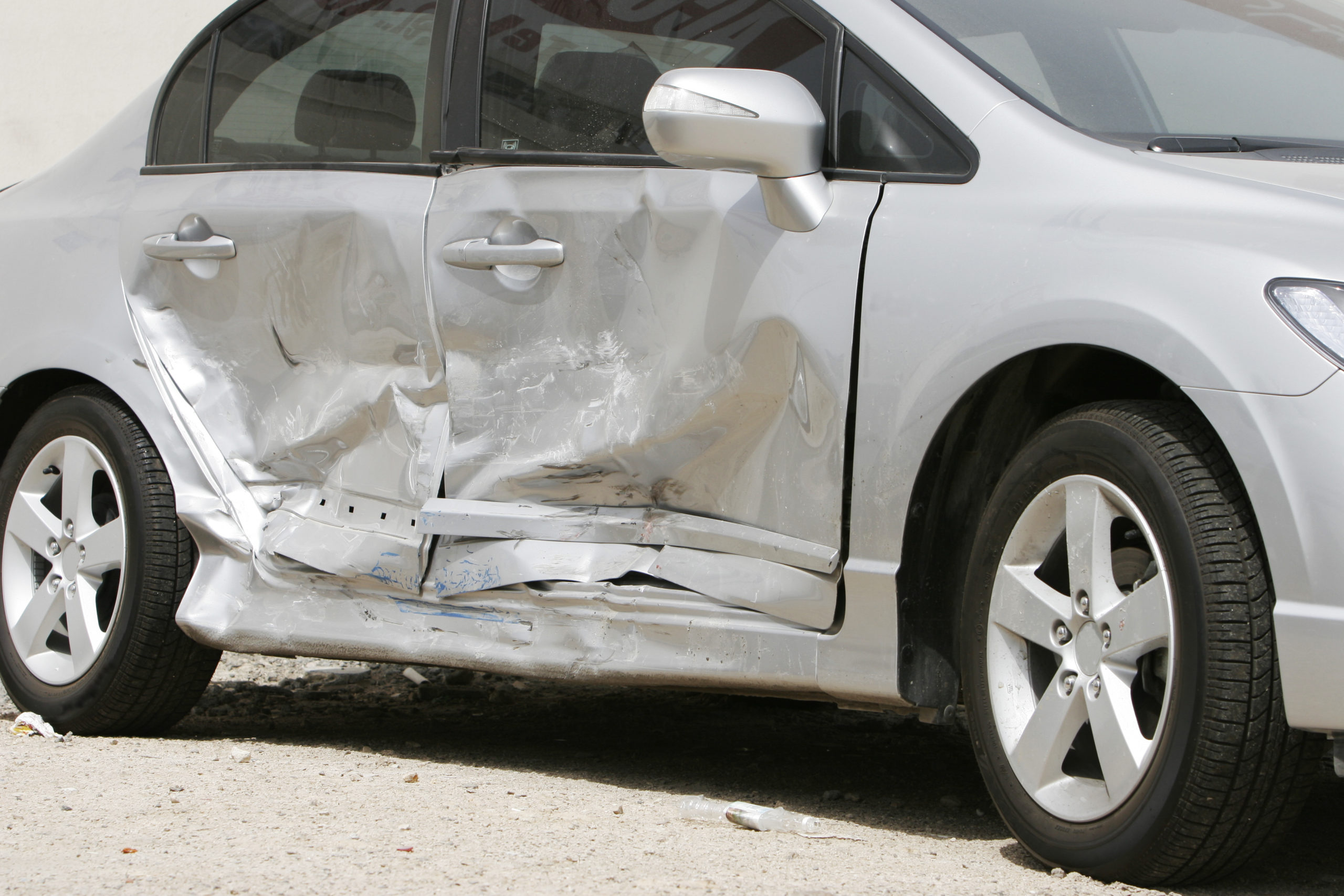
At best, being involved in a car accident can be an unwelcome inconvenience. At its very worst, it can be devastating, with life-altering consequences. Far from an exception, side-impact collisions are among the most dangerous types of traffic accidents, and often cause the most devastating injuries. Achieving justice and all of the compensation needed to make a full recovery can be a complicated task, but this burden will be made easier with the assistance of an experienced personal injury attorney.
What Is a Side-impact Collision?
A side-impact collision is a type of traffic accident where one vehicle crashes into the side of another vehicle at a perpendicular angle, with the vehicles forming a “T-shape.” These accidents commonly occur at intersections, where vehicles are customarily traveling in multiple directions. A side-impact collision is also commonly called a “T-bone collision” (the angle of the collision forms a T-shape) or a “broadside collision” (the side of a car is compared to the “broadside” of a ship).
Common Injuries Caused by Side-impact Collisions
Unfortunately, side-impact collisions are among the most severe types of traffic accidents. Most cars are not equipped with technology to protect drivers and passengers from impact with the sides of a car. In the case of a head-on or rear-end collision, drivers can usually rely on both airbags and the robust body of the car on either end to absorb much of the impact. The only things protecting drivers of most cars in the case of a side-impact collision are the car’s side doors.
Common injuries associated with these accidents include:
- Broken ribs
- Concussions and traumatic brain injuries
- Damage to the lungs and diaphragm
- Injuries to the legs and/or knees
- Lacerations from windows or flying glass
- Pelvic fractures
- Spleen injuries
- Spinal injuries
How Common Are Side-impact Collisions?
Side-impact collisions occur quite commonly. According to the National Highway Traffic Safety Administration, in 2018 alone, side-impact collisions caused 6,037 fatalities and 515,000 injuries in the U.S. It accounted for 17.9% of deaths caused by traffic accidents, exceeding the fatality rates for both head-on collisions (10.8%) and rear-end collisions (7.2%).
The statistics in New York follow a similar trend. The New York State DMV reports that in 2018, side-impact collisions accounted for 882 fatalities and 121,989 personal injuries.
What to Do if Involved in a Side-impact Collision in NY
No one plans to be involved in a side-impact collision (or any traffic accident at all, for that matter). As such, it can be incredibly stressful to figure out what happened and who is at fault. That’s why it is important to take certain steps immediately following an accident. Also note that New York law requires drivers to take the following actions after a traffic accident:
- Stop where it is safe to do so
- Exchange information with the other driver, including
- Name
- Driver’s license information
- Insurance information
- Vehicle registration
- Residence, including street and number
- License plate number
- Call 911 to report the accident if there is any personal injury
- If only property damage, there is no legal duty to call 911
New York also has a “good samaritan law.” It protects people who render medical aid at the scene of an accident from liability should the injured person claim the medical aid caused them further injury.
If any driver involved in an accident in New York sustains more than $1,000 in property damage resulting from the collision, all drivers must file a Report of Motor Vehicle Accident Form with the state’s Department of Motor Vehicles within 10 days from the time of the accident. If anyone is personally injured as a result of the collision, one must file an accident report form with the Department of Motor Vehicles.

Case Study: $50,000 (equivalent to $500,000 in today’s money)
What makes this case unique: Only 2 days to prepare and 1 day to find a key witness.
Options for Compensation When Involved in a Side-impact Collision
Once a side-impact collision has occurred, it is important to know one’s insurance options and consult the appropriate resources to be sure one can achieve justice. People involved in a side-impact collision in New York have four main options:
- No-fault or Personal Injury Protection Benefits
- Third-party Insurance Claims
- Filing a Lawsuit
- Small Claims Court
No-fault or Personal Injury Protection Benefits
The state of New York has a mandatory no-fault insurance law. Registered motorists are required to carry insurance, and in the event of a traffic accident, the insurance policy pays the medical expenses and lost wages of the policyholder, their passengers, and pedestrians hit by their car. The insurance pays up to a maximum amount of $50,000 per person regardless of who was at fault for the accident. The law also requires that, at a minimum, auto insurance protects policyholders against injuries suffered in an accident with an uninsured vehicle.
New York’s no-fault benefits are subject to significant limitations, including:
- Recovery only for medical expenses, lost earnings, and other reasonable and necessary expenses
- No vehicle damage claims
- No non-monetary claims, such as pain and suffering
One hoping to file a claim with their insurance should be aware of the following deadlines:
- No-fault claims must be filed within 30 days from the time of the accident
- Medical claims must be submitted within 45 days of treatment
- Loss of earnings claims (and other necessary expenses) may be submitted up to 90 days from when they are incurred
Third-party Insurance Claims
Sometimes the limited benefits provided by no-fault, personal injury protection are simply not enough. Car accidents–side-impact events in particular– can have devastating effects on one’s life beyond medical expenses and lost earnings. Where one’s injuries are substantial, New York’s state law provides options beyond the mandatory no-fault benefits.
New York Consolidated Laws ISC §51-5104 provides a threshold which must be met for one to go outside of the no-fault benefits protection and pursue a claim against the at-fault driver. The provision requires that one’s injuries be “serious,” defined in ISC §51-5102(d) to include:
- significant disfigurement
- bone fracture
- permanent limitation of use of a body organ or member
- significant limitation of use of a body function or system, or
- substantially full disability for 90 days
Other sufficient circumstances allowing one to go beyond no-fault benefits protection include:
- if expenses covered by no-fault benefits exceed $50,000 of coverage
- if the injury results in death
- if one making a claim does not have insurance that complies with New York law’s minimum coverage requirements
Once this threshold or any one of the sufficient circumstances is met, one injured in a side-impact collision may file a third-party insurance claim. A third-party claim is filed with the other involved driver’s insurance company. This avenue allows one to pursue non-monetary claims beyond medical expenses and lost wages, such as compensation for pain and suffering.
It is important to note that while this option does not usually involve filing a lawsuit, our personal injury attorneys know filing a claim presents complexities that can negatively affect the outcome if handled inexpertly and poorly. One should remember that insurance companies are not necessarily looking to pay out if they can avoid it. An attorney can prove crucial for things like:
- Arguing that one’s injury is “significant” enough to satisfy the threshold requirement
- Preparing one for the recorded statement they will make to the insurance agent investigating the claim
- Negotiating with the insurance company’s attorney
- Negotiating a fair settlement
Filing a Lawsuit
A second option outside of New York’s no-fault benefits system is filing a lawsuit against the at-fault driver or another person or entity responsible for the accident. Similar to a third-party insurance claim, filing such a lawsuit requires one to meet the “serious injury” threshold or other sufficient circumstance (discussed under the “Third-party Claim” section above). A lawsuit also provides the opportunity to pursue non-monetary claims, like compensation for pain and suffering, in addition to medical expenses and lost wages. The statute of limitations to bring a lawsuit is three years from the time of the accident.
Small Claims Court
A final option for one involved in a side-impact collision in New York is to pursue a claim in small claims court. As the name suggests, recovery in small claims court is very limited. UCT §18-1801 limits small claims court cases to $5,000 or less. A further restriction is that claims may only compensate for monetary damages, such as medical bills, and not for non-monetary damages, such as pain and suffering.
Determining Fault in a Side-impact Collision
In determining fault, both insurance adjusters and courts typically ask whether the accused driver was negligent. Negligence is a tricky legal concept, but the basic question is whether the driver either behaved in a careless way when they shouldn’t have, or were careless in failing to act when they should have. Negligent driving can take many forms:
- Impaired driving (driving while intoxicated)
- Aggressive and reckless driving (speeding)
- Distracted driving (texting)
- Driving while fatigued
- Failing to follow the rules of the road (not respecting another’s right of way)
Other circumstances commonly causing side-impact collisions include:
- Weather conditions
- Mechanical failure
When considering who is at fault, we interview the involved parties and any witnesses, and consult other resources providing evidence, such as traffic cameras. In the case of side-impact collisions, fault typically resides with the driver who did not have right of way. The negligent driver under these circumstances is usually the one who overstepped rather than the driver who failed to react. For example, when Jennifer’s car is hit on the side by Brad, who ran a stop sign, fault likely resides with Brad because he drove through the intersection when he was not supposed to; the rules don’t ask Jennifer to anticipate Brad’s failure to abide by the traffic laws.
Frequently Asked Questions
Not necessarily. Police do not directly determine which driver was at fault. When police are dispatched to the scene of a side-impact collision, they are required to create and file an accident report. Though the police report is not the only thing considered when determining fault, it can be an important piece of evidence, as it can include vital details such as whether or not one of the drivers was ticketed for a traffic violation. To obtain the police report filed after one’s traffic accident, one can contact the Department of Motor Vehicles or the investigating police agency.
Perhaps, but it is not the only factor. For example, one could run a red light and cause a collision with the side of their car and an oncoming vehicle with the right of way. The person running the red light might end up with far worse damage to their vehicle, but the fact that they did not have the right of way could make them the at-fault driver.
Failure to report an accident to one’s insurance most likely places one in violation of one’s policy in New York. They can provide an opportunity for the insurance company to refuse coverage for accident-related expenses claimed later on. It can also damage one’s case if the other driver files a third-party claim. The other driver would get a head-start preparing their claim, while the person who failed to report the accident might be at a disadvantage because their insurance company did not have time to investigate.
No. Even though New York law provides for no-fault insurance coverage, drivers involved in accidents such as a side-impact collision can step outside of the no-fault system if they reach the legal threshold. Admitting fault can be detrimental to one’s case if the other driver decides to pursue a third-party claim or lawsuit.
The legal concepts involved in determining fault can also be complicated and unclear. Therefore, one involved in a side-impact collision does not always know enough to say definitively whether they were at fault. As such, it is best to not admit fault when involved in a car accident.
Who Should I Contact if I’ve Been in a Side-impact Collision?
Being involved in a side-impact collision can have a devastating impact on the lives of those involved. The experienced personal injury attorneys at Rosenblum Law possess the expertise and passion necessary to ensure those injured in such an accident receive just compensation. E-mail or call 888-815-3649 for a free consultation.







 888-815-3649
888-815-3649
